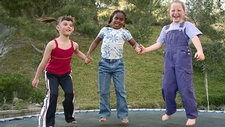Investigating Movement

TEKS Objective
The student will plan and conduct simple descriptive investigations such as ways objects move.
Essential Understanding
The student develops abilities to ask questions and seek answers in classroom and outdoor investigations.
Science Background
What is Inquiry Science Teaching? BioEd Online (video) - Strategies for using questions and investigations to guide your students’ science learning.
What is Inquiry Science Teaching?
BioEd Online, www.bioedonline.org
It’s Time for More Early Childhood Science: National Science Teachers Association (website) - Article that explains why primary students are at the perfect age to begin “discovering” science.
It’s Time for More Early Childhood Science
National Science Teachers Association, www.nsta.org
Signature Lesson
Making Objects Move: AAAS Science NetLinks (websites) - Students identify ways to make objects move and construct an object that moves.
Making Objects Move
AAAS ScienceNetLinks, www.sciencenetlinks.com
- Supporting Lessons
- Extensions
- Assessment Ideas
- Literature Connections
- Related
TEKS - Additional Resources
Supporting Lessons
Hoopster: Exploratorium (website) - Students investigate the question, How can a round paper hoop fly if airplane wings are flat? To find the answer, they build and test-fly their own paper hoops.
Elaboration Lessons and Extensions
Evaporation Exploration: American Chemical Society (PDF) - Students compare the rates at which water evaporates from cotton material and a paper towel.
Evaporation Exploration
American Chemical Society, portal.acs.org
Sink or Float? Science NetLinks (website) - Students predict, and then conduct an investigation to determine, whether certain items sink or float.
Assessment Ideas
Thinking back to the Signature Lesson, ask students, What do you think your test results would be like if you used half the number of pennies on your friction testers? How about twice as many? Have students write their predictions in their science notebooks, repeat the investigation using different numbers of pennies, and compare the results to their predictions.
Literature Connections
What is Science? Dotlich, Rebecca Kai (ISBN-13: 978-0805073942)
Forces Make Things Move. Brubaker, Kimberly (ISBN-13: 978-0064452144)
Moving Heavy Things. Adkins, Jan (ISBN-13: 978-0937822821)
Why Do Moving Objects Slow Down? A Look at Friction, Boothroyd, J. (ISBN-13: 978-0761360575)
TIME for Kids Super Science Book. Brent, Lynnette (ISBN-13: 978-1603208123)
Additional Resources
Choose a Project Idea: Discovery Education (website) - Students choose from a wide variety of testable questions related to plants and animals to serve as a basis for their own experiments and/or science fair projects. Includes guidance for investigating each question, including key issues to consider.
Choose a Project Idea
Discovery Education,school.discoveryeducation.com
TEKS Navigation
Grade 1
Need Assistance?
If you need help or have a question please use the links below to help resolve your problem.

Comments